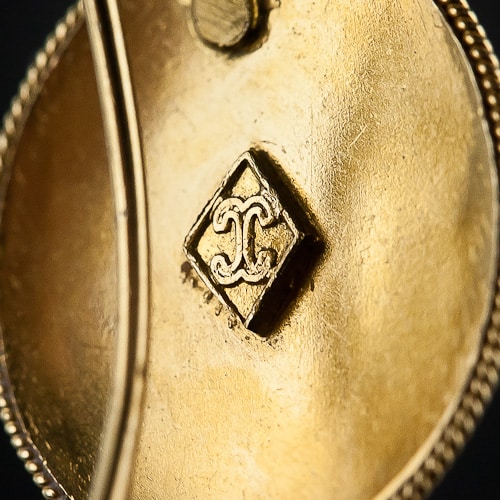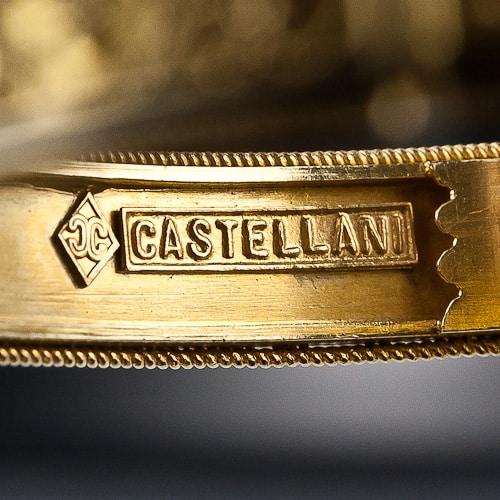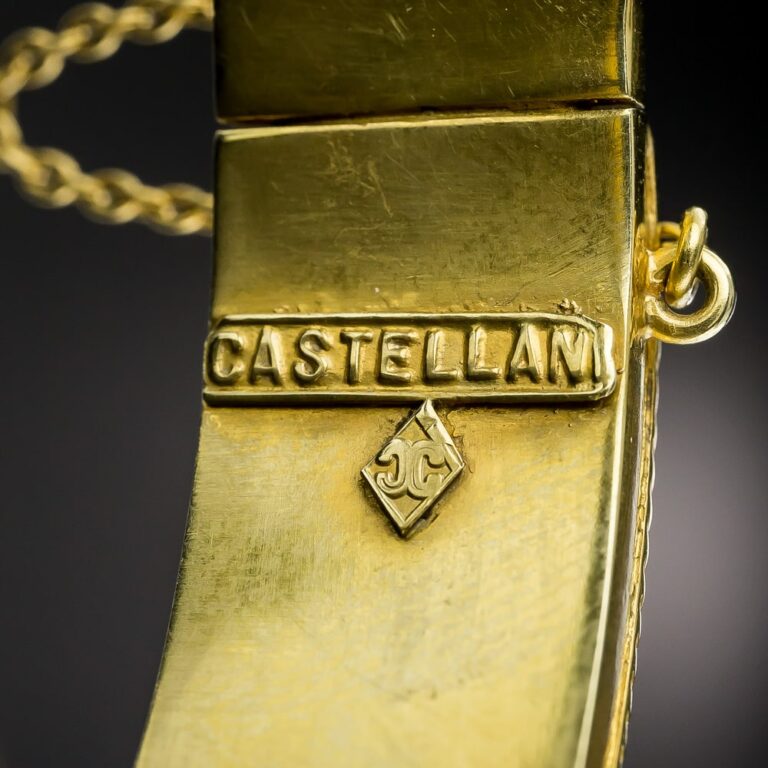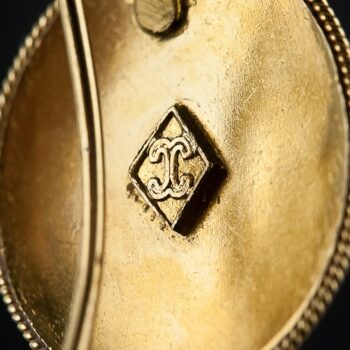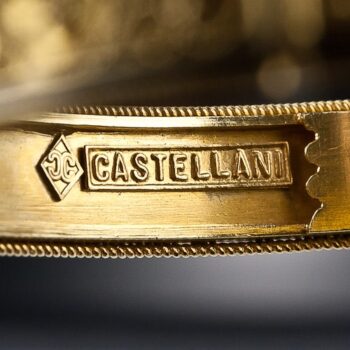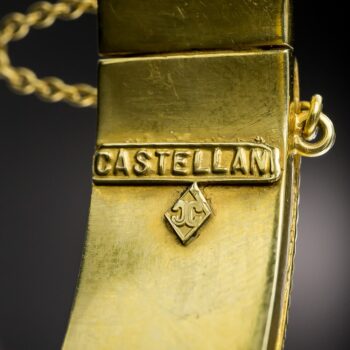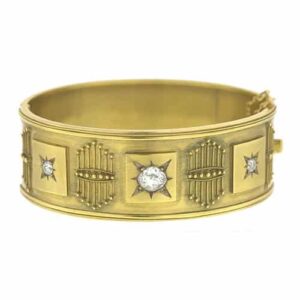
Castellani was the Italian jeweler who initiated the archaeological revival movement in the mid-nineteenth century. Castellani’s founder, Fortunato Pio Castellani, opened up shop in Rome in 1814. In 1826, he met his lifelong friend and collaborator Michaelango Caetani at a lecture where he was speaking about how to recreate the look of ancient gold. According to jewellery historians, Caetani “gave Fortunato Pio the idea to imitate and seek inspiration from Ancient jewellers.”1
Caetani was a Dante scholar, a historian, a talented woodworker and an artist familiar with jewellery manufacturing techniques. He was also a darling of Roman high society. Though Caetani was never formally employed by the firm, his creativity and connections helped the Castellanis to prosper.
By the early 1830s, Fortunato Pio had begun making archaeological-style jewellery. In 1836, when the Etruscan Regolini-Galassi tombs were opened, papal authorities invited him to study the jewellery found there. In the 1840s and ’50s, he and his sons, Alessandro and Augusto, were also given access to the huge collection of antiquities acquired by the director of the papal savings bank, Marchese Fiolanni Pietro Campana. While now dispersed, the Campana collection was then complete and at the Castellanis’ fingertips. They realized that the ancients created their designs by adding detail to the metal rather than carving, punching, cutting, and otherwise deforming the metal to create an effect. They were able to recreate the look and feel of these Ancient pieces using granulation, wirework, and other old-style gold working techniques. Such techniques had been seemingly lost for centuries until the brothers discovered a remote area of the Apennines where they were still being practiced.
In the 1860s, Castellani vaulted into fame as popular fascination with archaeological finds grew. Exiled from Rome due to his political views in 1860, Alessandro (the older Castellani brother) busied himself with marketing the firm’s jewellery abroad. First setting up shop on the Champs Elysées in Paris, he lectured widely on Ancient jewellery and socialized with Parisian high society, even gaining a presence with Napoleon III, to whom he presented a collection of Castellani jewellery. Alessandro also organized the firm’s first displays at international exhibitions: Florence (1861) and London (1862). In 1862, he left Paris after having an affair with, and impregnating, a married woman. He moved to London and, shortly thereafter, to Naples, where he set up his own jewellery workshop.2
The firm is also known for incorporating ancient, medieval, and modern intaglios and cameos, as well as Egyptian scarabs and micro-mosaics into their pieces. According to jewellery historians, the firm was the first to place micro-mosaics, often with Early Christian, Byzantine, and Egyptian designs, in archaeological style frames.3 Luigi Podio was the master mosaicist for the famed archaeological revival jeweler. Podio’s workshop in Rome created some of the finest and most detailed mosaics of the period. The higher quality and exquisite detail of the mosaics in Podio’s workshop rose well above the coarser production of his peers. Podio supervised the mosaic studio from 1851 to 1888.
The firm’s designs continued to be wildly popular. At the 1867 international exhibition in Paris, “nearly all” of the jewellers featured Archaeological-style jewels in their showcases.4 The firm’s success peaked in the 1870’s. In the 1880’s, the Rome location was handed over to Augusto’s son, Alfredo. Until his death in 1914, Augusto busied himself with, among other things, attempting to “document the progression of Italian goldsmiths art from pre-historical times to the present.”5 He suggested eight time periods: primitive, Tyrrhenian, Etruscan, Sicilian, Roman, medieval, Renaissance, and modern. Though his categories are not accepted as exhaustive today, it was one of the first modern attempts to divide the history of jewellery design into eras. In 1930, Castellani closed its doors when Alfredo, the last in the line of Castellani jewellers, died.
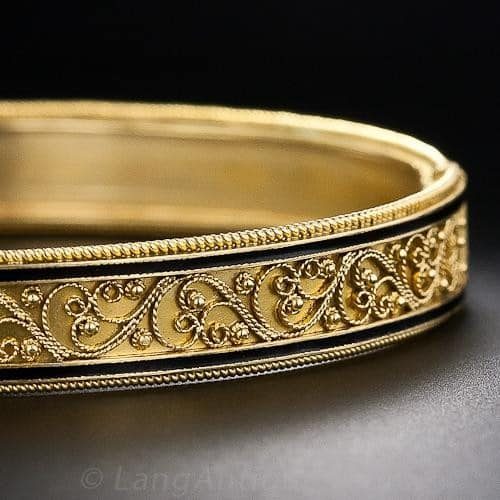
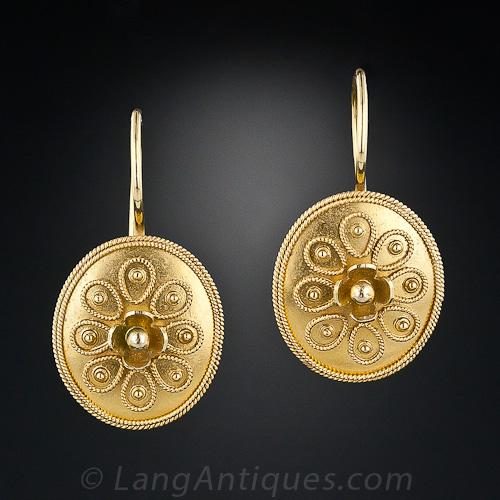
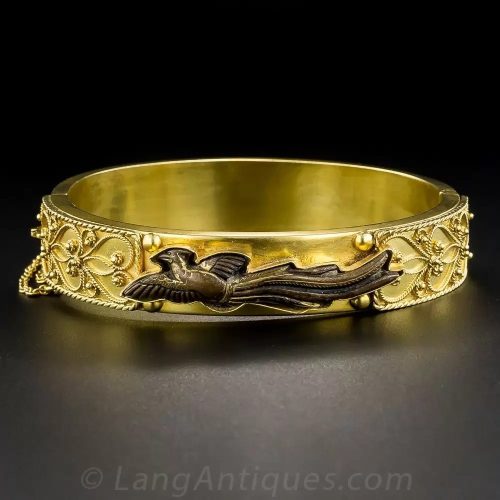
Maker's Marks & Timeline
Castellani
| Country | |
|---|---|
| City | London, Rome |
| Symbol | cartouche, diamond, frame, rectangle |
| Shape | cartouche, diamond, frame, rectangle, rhombus |
| Era | e. c.1816 |
Specialties
- Goldsmiths and jewelers working in the archaeological style.
- Specialized in goldwork, not precious stones.
‘1814 Castellani apprenticed with his father in Rome.
1826
- Began production of gold jewelry based on early Roman excavations with filigree.
1836
- Advisor at the excavation of the Regulini Galassi tomb with a historic cache of Etruscan metalwork.
- His passion turned to deciphering the secrets of these ancient goldsmiths.
1848
- Closed temporarily due to the Italian political climate
1851
- Fortunato Pio Castellani (1793-1865) retires.
1858
- Alessandro and Augusto Castellani re-opened the workshop
1862
- International Exhibition, London
- Featured their Etruscan-style jewelry with granulation.
1860s
- Became a tourist destination for Archeological Revival jewelry. Opening of Paris and London workshops.
1930
- Closed after the death of Alfredo.
